COURSE SYLLABUS
- 格式:doc
- 大小:95.00 KB
- 文档页数:11
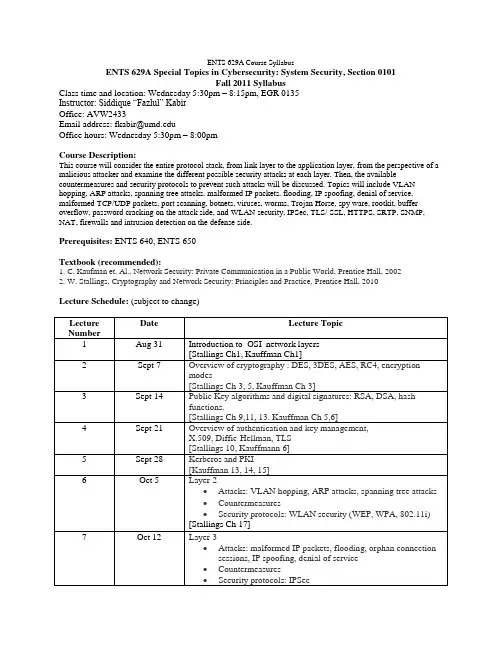
ENTS 629A Course SyllabusENTS 629A Special Topics in Cybersecurity: System Security, Section 0101Fall 2011 SyllabusClass time and location: Wednesday 5:30pm – 8:15pm, EGR 0135Instructor: Siddique “Fazlul” KabirOffice: AVW2433Email address: fkabir@Office hours: Wednesday 5:30pm – 8:00pmCourse Description:This course will consider the entire protocol stack, from link layer to the application layer, from the perspective of a malicious attacker and examine the different possible security attacks at each layer. Then, the available countermeasures and security protocols to prevent such attacks will be discussed. Topics will include VLAN hopping, ARP attacks, spanning tree attacks, malformed IP packets, flooding, IP spoofing, denial of service, malformed TCP/UDP packets, port scanning, botnets, viruses, worms, Trojan Horse, spy ware, rootkit, buffer overflow, password cracking on the attack side, and WLAN security, IPSec, TLS/ SSL, HTTPS, SRTP, SNMP, NAT, firewalls and intrusion detection on the defense side.Prerequisites: ENTS 640, ENTS 650Textbook (recommended):1. C. Kaufman et. Al., Network Security: Private Communication in a Public World, Prentice Hall, 20022. W. Stallings, Cryptography and Network Security: Principles and Practice, Prentice Hall, 2010Lecture Schedule: (subject to change)Grading:Class Attendance 10%Projects 30%Mid Tern exam 30%Final exam 30%Additional Readings:C. Pfleeger and S. Pfleeger, Security in Computing, 4th edition, Pearson Education, 2007Academic Integrity:The University of Maryland, College Park has a nationally recognized Code of Academic Integrity, administered by the Student Honor Council. This Code sets standards for academic integrity at Maryland for all undergraduate and graduate students. As a student you are responsible for upholding these standards for this course. It is very important for you to be aware of the consequences of cheating, fabrication, facilitation, and plagiarism. For more information on the Code of Academic Integrity or the Student Honor Council, please visit/code.html.。
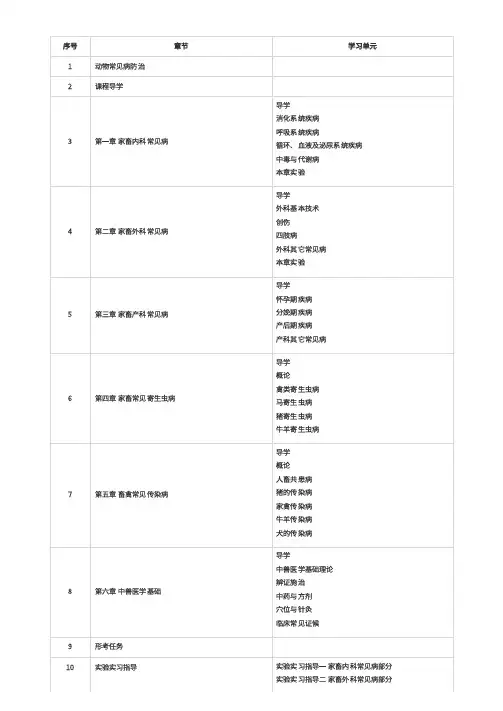
序号章节学习单元1动物常⻅病防治
2课程导学
3第⼀章 家畜内科常⻅病导学
消化系统疾病
呼吸系统疾病
循环、⾎液及泌尿系统疾病中毒与代谢病
本章实验
4第⼆章 家畜外科常⻅病导学
外科基本技术创伤
四肢病
外科其它常⻅病本章实验
5第三章 家畜产科常⻅病导学
怀孕期疾病
分娩期疾病
产后期疾病
产科其它常⻅病
6第四章 家畜常⻅寄⽣⾍病导学
概论
禽类寄⽣⾍病⻢寄⽣⾍病猪寄⽣⾍病⽜⽺寄⽣⾍病
7第五章 畜禽常⻅传染病导学
概论
⼈畜共患病猪的传染病家禽传染病⽜⽺传染病⽝的传染病
8第六章 中兽医学基础导学
中兽医学基础理论辨证施治
中药与⽅剂
⽳位与针灸
临床常⻅证候
9形考任务
10实验实习指导实验实习指导⼀ 家畜内科常⻅病部分
实验实习指导⼆ 家畜外科常⻅病部分
实验实习指导三 家畜产科常⻅病部分实验实习指导四 畜禽常⻅传染病部分实验实习指导五 家畜常⻅寄⽣⾍病部分实验实习指导六 中兽医部分
11课程思政优秀与你同⾏
说说你是如何⽴⾜专业、服务乡村振兴的?
12资源列表
13微课程
14讨论区
15调查问卷
16总部资源更新区
17分部⾃建资源区
18学⽣⽀持服务
19课程教学学⽣满意度问卷。
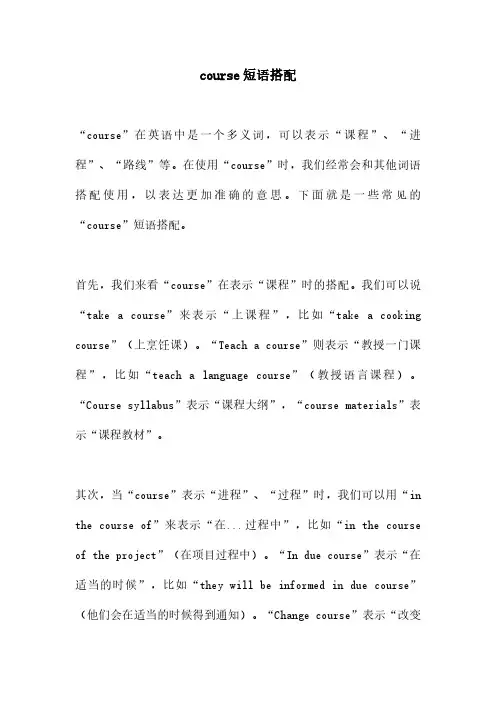
course短语搭配“course”在英语中是一个多义词,可以表示“课程”、“进程”、“路线”等。
在使用“course”时,我们经常会和其他词语搭配使用,以表达更加准确的意思。
下面就是一些常见的“course”短语搭配。
首先,我们来看“course”在表示“课程”时的搭配。
我们可以说“take a course”来表示“上课程”,比如“take a cooking course”(上烹饪课)。
“Teach a course”则表示“教授一门课程”,比如“teach a language course”(教授语言课程)。
“Course syllabus”表示“课程大纲”,“course materials”表示“课程教材”。
其次,当“course”表示“进程”、“过程”时,我们可以用“in the course of”来表示“在...过程中”,比如“in the course of the project”(在项目过程中)。
“In due course”表示“在适当的时候”,比如“they will be informed in due course”(他们会在适当的时候得到通知)。
“Change course”表示“改变方向”、“调整计划”,比如“we need to change course and find a new solution”(我们需要改变方向,找到新的解决方案)。
最后,当“course”表示“路线”时,我们可以用“course of action”来表示“行动方针”、“行动计划”,比如“we need to decide on a course of action”(我们需要决定一个行动方针)。
“Of course”则表示“当然”,用来表示肯定或同意,比如“are you coming to the party?-of course!”(你来参加聚会吗?-当然来!)总的来说,“course”作为一个多义词,在使用时需要根据具体语境来选择合适的搭配词,以确保表达准确、流畅。
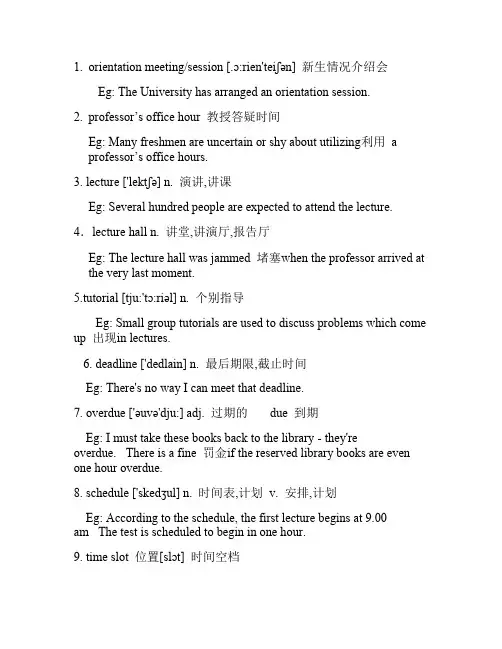
1.orientation meeting/session [.ɔ:rien'teiʃən] 新生情况介绍会Eg: The University has arranged an orientation session.2.professor’s office hour 教授答疑时间Eg: Many freshmen are uncertain or shy about utilizing利用aprofessor’s office hours.3.lecture ['lektʃə] n. 演讲,讲课Eg: Several hundred people are expected to attend the lecture. 4.lecture hall n. 讲堂,讲演厅,报告厅Eg: The lecture hall was jammed 堵塞when the professor arrived at the very last moment.5.tutorial [tju:'tɔ:riəl] n. 个别指导Eg: Small group tutorials are used to discuss problems which come up 出现in lectures.6. deadline ['dedlain] n. 最后期限,截止时间Eg: There's no way I can meet that deadline.7. overdue ['əuvə'dju:] adj. 过期的due 到期Eg: I must take these books back to the library - they'reoverdue.There is a fine 罚金if the reserved library books are even one hour overdue.8. schedule ['skedʒul] n. 时间表,计划v. 安排,计划Eg: According to the schedule, the first lecture begins at 9.00 am The test is scheduled to begin in one hour.9. time slot 位置[slɔt] 时间空档Eg: If you have two final exams scheduled at the same time, you will have to move one exam to another time slot空位位置10.signature ['signitʃə] n. 签字,签名Eg: Each child must obtain获得获取the signature of his or her parents11.thesis ['θi:sis] n. 毕业论文Eg: a master's/doctoral thesis on the effects of global warming 12.dissertation [.disə'teiʃən] n. 论文Eg: He wrote his dissertation on an obscure晦涩的16th-century poem.13.course [kɔ:s] n. 课程Eg: compulsory强制的/required/mandatory义务的强制的course; elective course, optional course;foundation course, introductory course, intermediate中间的level course, advanced course14.elective [i'lektiv] n. 选修科目Eg: She took three electives last term.15. option ['ɔpʃən] n. 选修科目Eg: She is taking French as an option next year16.assignment [ə'sainmənt] n. 功课,任务Eg: I have a lot of reading assignments to complete before the end of term.17.presentation [.prezen'teiʃən] n. (国外学生在课堂上所做的)演讲Eg: The speaker gave an interesting presentation on urban transport.18. field work 野外考察实地考察Eg:Offered by most departments for academic credit, field work enables students to examine the way the theories and the practical experiences of a particular discipline 学科训练纪律惩罚interact相互作用(学科互动).19. attendance [ə'tendəns] n. 出勤, 上课Eg: Attendance at lectures is compulsory.20.skip/miss classes 缺课, 旷课Eg: He skipped chemistry class three times last month21. tuition fees 学费Eg: Many students will not have to pay tuition fees if their financial situation is below a certain level.22. course syllabus ['siləbəs] 课程大纲Eg: Course syllabus lists the course objectives目标, required reading assignments, examination dates, and other course requirements such as attendance23. handout ['hændaut] n. 讲义Eg: I e-mailed you about getting the handouts from the class I missed the other day.24. semester=term [si'mestə] n. 学期Eg: How many subjects are you studying this semester25. practicum ['præktikəm] n. 实习科目,实习课Eg: A practicum is a college course, often in a specialized field of study, that is designed to give students supervised 管理practical application of a previously or concurrently studied theory.26. placement service 就业办公室Eg: Placement service is a campus office that provides job listings from local or campus employees and assists students in finding full-time jobs after graduation27.take on a part-time job从事兼职工作Eg: He had taken on a part-time job selling all-natural products.28.transfer [træns'fə:] v 转班, 转学Eg: I was able to transfer my credits from summer school29.extension [iks'tenʃən] n. 延期Eg: Donald's been given an extension to finish his thesis30.examination [ig.zæmi'neiʃən] n. 考试Eg: The examination results will be announced in September.31.pop quiz 突击考试Eg: We have a history pop quiz every Monday.32.mid-term exam 期中考试Eg: Alison has a history mid-term exam next week.33.final exam 期末考试Eg: The final exam for this class will be on May 21st.When is your chemistry/French/algebra 代数final?34.teaching assistant 助教Eg: A teaching assistant (TA) is an individual who assists a professor or teacher with instructional responsibilities.35.instructor=lecturer [in'strʌktə] n. 教师,讲师Eg: He's a poetry instructor at a local community college.36.spring break 春季学期间的短假期Eg: In the United States, the timing of spring break in tertiary第三级的institutions 高等教育机构may range from the beginning of March to the later part of April, but many schools are in recess休息for at least one of the weeks in March37.review [ri'vju:] vt.温习, 复习(go over)Ex :We'll spend this week reviewing for the final.38. tutor ['tju:tə] n. 家庭教师Eg: His tutor encouraged him to read widely in philosophy.39. tutoring 家庭辅导Eg: I have to do some tutoring to pay my tuition fees.Tutoring can be defined as people who are not professional teachers helping and supporting the learning of others in an interactive, purposeful and systematic way.40. internship ['intə:nʃip] n. 实习Eg: Jane has a summer internship at a local TV station.41. assistantship [ə'sistənt.ʃip] n. 研究生助教奖学金Eg: Graduate students have several sources of funding, but perhaps the most common is the assistantship42. gym/sports center/health center 健身中心Eg: I try and work out at the local gym once a week.43. lost and found 失物招领处Eg: A lost and found is an office in the university where students can go to retrieve 找回lost articles that may have been found by other students.44. health insurance 医疗保险Eg: A health insurance policy is a contract between an insurance company and an individual42. student I.D. number 学号Eg: Students have an I.D number, with which they login onto the school's website and access assignments.43. snack bar 小吃店Eg: A snack bar is a place where you can buy snacks or small meals 44. online course 网络课程Eg: Online courses enable us to extend the opportunity of studying with the University of Oxford to students anywhere in the world, in a way that fits with the busiest of lives.45. plagiarism ['pleidʒiərizəm] n. 剽窃Eg: The journal accused谴责the professor of plagiarism.46. curriculum [kə'rikjuləm] n. 课程,全部课程Eg: Languages are an essential part of the school curriculum.47. audit ['ɔ:dit] 旁听Eg: As a senior citizen, he is allowed to audit university classes.48. multiple choice questions 多项选择题Eg: A multiple choice examination or question shows several possible answers, and you have to choose the correct one49. grade, score, mark 分数成绩Eg: Tim worked hard and got good grades.The school's test scores have not improved Her marks have been a lot lower this term50. GPA 平均成绩点数(=grade point average)Eg: A cumulative 累积的渐增的grade point average is calculated as an indicator 指示物of overall academic performance in a program and is used as a criterion for graduation requirements51. withhonours ['ɔnəz] n. 优异成绩Eg: If you complete a school or university qualification 资格合格证书限定条件with honours, you achieve a high standard.She graduated with (top/high) honors.52. the stacks [plural] 书架Eg: I couldn't find the book in the stacks.53. commencement n. [kə'mensmənt] 毕业典礼(=graduation ceremony)Eg: During commencement degrees or diplomas学位证书are given to students who have graduated from a school or college54. report card/grade report成绩报告Eg: In most places, the report card is issued by the school to the student or the student's parents twice or four times yearly.55. abstract ['æbstrækt] n. 摘要Eg: There is a section at the end of the magazine which includes abstracts of recent articles/books.56. summary ['sʌməri] n. 摘要Eg: At the end of the news, they often give you a summary of the main news stories.57. Literature Review ['litərətʃə] 文献综述Eg: The ultimate 根本的最终的goal of literature review is to bring the reader up to date with current literature on a topic58.references/bibliography [.bibli'ɔgrəfi] n. 参考书目Eg: Bibliography usually appears at the end of the thesis.59.term paper n. 学期论文Eg: Bill has written only one-third of his term paper that is due tomorrow60.graduate school application 研究生申请Eg: My professor offered me some advice concerning the wording of my graduate school application61.transcript ['trænskript] n. 成绩单成绩单Eg: I want to continue my studies. I would appreciate it if you could send me a transcript62.diploma [di'pləumə] n. 文凭Eg: Anyone with a high school diploma can enroll in the course.I’d like to drop off my graduation form. I understand you need this in order to process my diploma.63. recall [ri'kɔ:l] v. 召回Eg: If the book is recalled by other students then you have to return it within 7 working days.64.certificate [sə'tifikit] n. 证书Eg: high school/college diploma65.scholarship ['skɔləʃip] n. 奖学金Eg: She got/received/won a scholarship to Yale University66.fellowship ['feləuʃip] n. 研究生奖学金Eg: She's applied for a research fellowship.67.grant [grɑ:nt] n. 资助Eg: They gave/awarded her a grant to study abroad for one year.68.registration [.redʒi'streiʃən] n. 注册Eg: Registration for the course will take place a week before the start of term.69.sign up for 报名参加选课Eg: She's signed up for evening classes at the community college. 70.major ['meidʒə] n. 主修专业Eg: He chose history as his major and French as his minor71.minor ['mainə] n. 副修专业Eg: She majored in chemistry with a minor in biology72.academic advisor 学习顾问Eg: Academic advisors provide students with accurate information about academic progression and degree requirements.73.approval [ə'pru:vəl] n. 允许许可Eg: I need to get the professor’s signature on my schedule card here, on the li ne above advisor’s approval.74.quit/drop 放弃退课Eg: I have to drop my chemistry course last semester when I went into the hospital, so I need to take it again.75.credit ['kredit] n. 学分Eg: He's already got a credit/three credits in earth science76.registrar ['redʒi.strɑ:] n . (学校)注册主任Eg: at some colleges, an official in charge of examinations, keeping records and admitting new students77.enroll [in'rəul] v. 登记Eg: I enrolled for/in/on the modern art course.78.library ['laibrəri] n. 图书馆Eg: The library loans books, CDs and videotapes.79.student ID card 学生证Eg: You have to show your student ID card in order to go to the university gym.80.library card 借书证Eg: I’ve lost my library card and I can’t borrow any books until I geta new one.81.fiction ['fikʃən] n. 小说Eg: The book is a work of fiction and not intended as a historical account.82.non-fiction 非小说Eg: Non-fictions include dictionaries and reference books.83.reference book(=reference) 参考书Eg: The reference book I want to borrow has been put on reserve by the professor.84.encyclopedia [en.saikləu'pi:diə] n. 百科全书Eg: Does anyone know when Mozart was born?" "Look it up in the encyclopedia."85.periodical [.piəri'ɔdikəl] n. 期刊Eg: She has written for several legal periodicals.86.magazine [.mægə'zi:n] n. 杂志Eg: She's the editor of a popular women's magazine.87.current issue 现刊Eg: Current issues are put on the shelves in the periodical section. 88.back issue 过刊Eg: Back issues of newspapers are put in the basement of the library.89.journal ['dʒə:nl] n. 学术杂志Eg: The library subscribes to all the major science journals.90.newspaper ['nju:z.peipə] n. 报纸Eg: Which newspaper do you read regularly, Daily or Sunday newspaper?91.atlas ['ætləs] n. 地图册Eg: an atlas of the world92.almanac ['ɔ:lmənæk] n. 年鉴Eg: a book published every year that contains facts and information such as important days, times of the sun rising and going down or changes in the moon93.video 录像带Eg: We're going to rent a couple of videos to watch this weekend 94.VCR 录像机= Video Cassette RecorderEg: a machine you use to record television programs or play videotapes95.declare a major 选专业Eg:You must declare a major by the end of your sophomore year puter access电脑使用Eg: Computer access is provided in all the sections of the library97.internet service网络服务98.online database 在线数据库Eg: We're linked to the on-line database at our head office.99.project 功课任务Eg: In our third year at college everyone had to do a special project.I am having problem with my group project100.cram [kræm] v.仓促备考Eg: She's cramming for her history exam.101.photocopier ['fəutə.kɔpiə] n. 复印机Eg: I have a photocopier in my office that automatically sorts sheets of paper into different bins.102.photocopy 复印Eg: I'll just make a photocopy of the agreement.Could you photocopy those three pages for me, please?103.printer 打印机Ex :The future of high-quality printing in businesses belongs to laser printers.104.interlibrary service 图书馆馆际互借服务Eg: Interlibrary services are services provided mutually by libraries with the aim of making library documents, irrespective of the place where they are deposited, available to all their users.105.closed reserve 非外借书库Eg: If a print resource will be in high demand they can request that item placed in the Closed Reserve.106.put ...on reserve 把资料放在非外借书库Eg: The librarian has put the book on reserve for me107.multimedia 多媒体Eg: We bought a multimedia encyclopedia108.online catalogue ['kætəlɔ:g] n. 在线书目Eg: There is a new catalogue of all the books in the library.109.keyword 关键字Eg: You can type in the keyword to locate the book you are looking for.110.call number 索书号Eg: A call number is a group of numbers and/or letters put together to tell you where in the library to find your book.111.check out 办理外借手续Eg: Residents now have to pay $50 a year to check out books from the state university library112.recall [ri'kɔ:l] n. 召回Eg: If an item is recalled, it's loan period will be shortened to two weeks113.circulation desk [.sə:kju'leiʃən] 借书台Eg: When visiting the library in person, you can bring the material you want to check out to one of two circulation desks on the main level of the library.114.loan period/borrowing period [ləun] 借书期限Eg: The loan period for circulating materials varies according to the status of the borrower.115.renew [ri'nju:] v. 续借Eg: He renewed the book for another two months116.overdue ['əuvə'dju:] adj. 过期的Eg: The library books are overdue.117.fine [fain] n. 罚款,罚金Eg: I got a fine for not returning library books on time.118.bachelor's degree 学士学位Eg: He graduated from North Dakota State University in 1993 with a bachelor's degree in civil engineering.119.grade point average (学生各科成绩)平均积分点Eg: Despite this tragedy, she graduated with the second highest grade point average in her high school.120.general education 通识教育Eg: All courses in the General Education program strive to stimulate critical or analytic thinking121.discipline ['disiplin] n. 学科Eg: History and economics only became separate academic disciplines in the 20th century.122.vacation [vei'keiʃən] n. 假期,休假Eg: We're taking a vacation in June.123.prerequisite ['pri:'rekwizit] n. 先决条件Eg: Passing a written exam is a prerequisite for taking the advanced course.124.quarter ['kwɔ:tə] 四分之一学年Eg: A quarter is one of four periods into which the school year is divided125.counselor ['kaunsələ] n. 顾问126.department chairEg: He was elected department chair of the physics department. 127.dean [di:n] n. 系主任,学院院长Eg: She is the new dean of the Faculty of Social Sciences.the Dean of Medicine128.faculty ['fækəlti] n.全体教员;(大学的)系,科,院Eg:the Arts/Law Facultythe Faculty of Science129.drop out 退学Eg: He dropped out of college when he was 20.130.make-up test 补考Eg: I have to take a make-up test because I got the flu on the test day 131.expel [iks'pel] v 开除Eg: Two girls were expelled from school for taking drugs.132.student union 学生会Eg: In colleges and universities, the student union is often accorded its own building on the campus, dedicated to social and organizational activities of the student body.133.degree [di'gri:] n. 学位Eg: She's got a bachelor's/master's degree in history from Yale.134.freshman ['freʃmən] n. 大学一年级学生Eg: He's a freshman at Harvard.135.sophomore ['sɔfəmɔ:] n. 大学二年级学生Eg: A sophomore is a student studying in the second year of a course at a US college136.junior ['dʒu:njə] n.Eg: a junior at NYU137.senior ['si:njə] n.Eg: Jen will be a senior this year.138.dormitory ['dɔ:mitri]Eg: He soon gets accustom to dormitory life and make two or three friend139.roommate ['ru:mmeit] n. 室友Eg: Jean was my roommate during our first year at university. 140.off campus 在校园外的Eg: The Off Campus Housing office provides information to members of the Johns Hopkins community looking for a place to live near the university.141. title ['taitl] n. 标题,头衔,称号Eg: I've read one of her books, but I can't remember the title.142. skim [skim] vt.略读Eg: It took me an hour to skim the book143. graph [grɑ:f] n. 图表,示意图Eg: This graph shows how crime has varied in relationship to unemployment over the last 20 years.144. chart [tʃɑ:t] n. 图表Eg: He illustrated his theory by using charts and graphs.145. draft [dræft] n. 草稿Eg: She asked me to check the (first) draft of her proposal.146. register ['redʒistə] v. 记录,登记,注册Eg:Did you registers already for classes next semester?147. seminar ['seminɑ:] n. 研究会,讨论发表会Eg: Professor White's seminar was cancelled.148. master’s degr ee n. 硕士学位Eg:Master’s degree is an academic degree higher than a bachelor's but lower than a doctor's149. bulletin board ['bulitin] 告示牌Eg: The classroom assignment sheet is posted on the bulletin board. 150. cancel ['kænsəl] v. 取消Eg: The class has been cancelled because not enough students signed up for it.151. administration office/building 行政办公室/楼Eg: He was looking for the administration building to drop off his graduation form.152. overwhelmed [.əuvə'welm] v. 由于工作、功课量大而忙不过来Eg: I am a little overwhelmed by the size of this university.153.swamped [swɔmp] v. 由于工作、功课量大而忙不过来Eg: I'm swamped with work at the moment.154. feedback ['fi:dbæk] n. 反馈,成果Eg: Every Friday, Mr. James would hand out the students' essays and give them some feedback.155. audition [ɔ:'diʃən] n. 试听;试演Eg: His audition went well and he's fairly hopeful about getting the part.156. career fair 招聘会Eg: He went to the career services office to confirm the date and time of the career fair.157. linguistics [liŋ'gwistiks] n. 语言学Eg: Linguistics is the systematic study of the structure and development of language in general or of particular languages158. accounting [ə'kauntiŋ] n. 会计;会计学Eg: In order to deal with the problems of budgeting for this it is necessary to know something of company financial and cost accounting.159. pointer ['pɔintə] n. 暗示,线索,点子Eg: I want some pointers where to go for information on this subject. 160. textbook ['tekstbuk] n. 课本,教科书Eg: I can't get hold of any of the college textbooks he recommended.Most economics textbooks skip over the subject of investing and financial markets.161. apply for 申请Eg: We've applied to a charitable organization for a grant for the project.162. résumé [ˈrɛzəˌmeɪ] n. 简历,履历Eg: She sent her résuméto fifty companies, but didn't even get an interview.163. stop by 偶然过访,靠近,访问(=come by)Eg: Can you stop by for a moment on your way home from your firm 164. submit [səb'mit] v. 呈送,递交(=hand in/turn in)Eg: Please su bmit your application form before the deadline.165. outline ['əutlain] n. 大纲Eg: In this paper I will give a broad outline of the research we have been doing.166. blank out 忘记Eg: I blanked out during the exam.167. shelf [ʃelf] n. 书架Eg: I couldn’t find the book I wanted on the shelf.168. clarify ['klærifai] vt.澄清,阐明,使... 明晰Eg: The teacher's explanation clarify the puzzling problem169.synthesis ['sinθisis] n. 综合Eg: The teacher asked me to write a synthesis of what I had observed and read.170. revise [ri'vaiz] v. 校订,修正,校正Eg: My professor asked to revise the first draft of the thesis.171. poster ['pəustə] n. 海报Eg: He put up a poster advertising the career fair.172. flyer ['flaiə] n. 传单Eg: Flyers are inexpensive to produce and are regarded as a very effective form of direct marketing173. come up 出现,发生Eg: Should he be watching TV now with the exams coming up next week174. pick up 取拿领Eg: When you're in town could you pick up the books I ordered?Have you picked up your ID card from the office yet?175. break 短暂的休息时间课间休息Ex. Would you like to take a break and get a soda?176 give away vi. 赠送,送出Ex. I gave away all my out-of-date science texts when I moved?177. cover v. 覆盖,涉及,包含Ex. We are rapidly nearing the end of this course in the history of classical music. We have covered several centuries in a very short time178. accept v 录取Eg: Because Susan was accepted by the state university, her brother Ben applied there too.179. overhead projector 投影仪Eg:I can run this overhead projector There’s really nothing to do it. 180.out of print (书等)已绝版的,已售完的Eg:Her first novel is out of print now but you may find a second-hand copy.181. note [nəut] n. 笔记Eg: Mind if I borrow your economics notes for a while?182. language lab 语音室Eg:Shall I lock the language lab now before I go home183. appointment [ə'pɔintmənt] n. 预约Eg: I have an appointment to see Doctor Gram for a physical examination.。
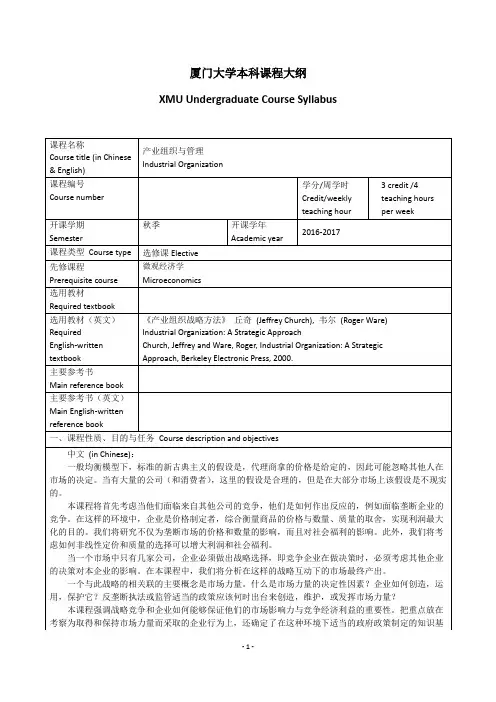
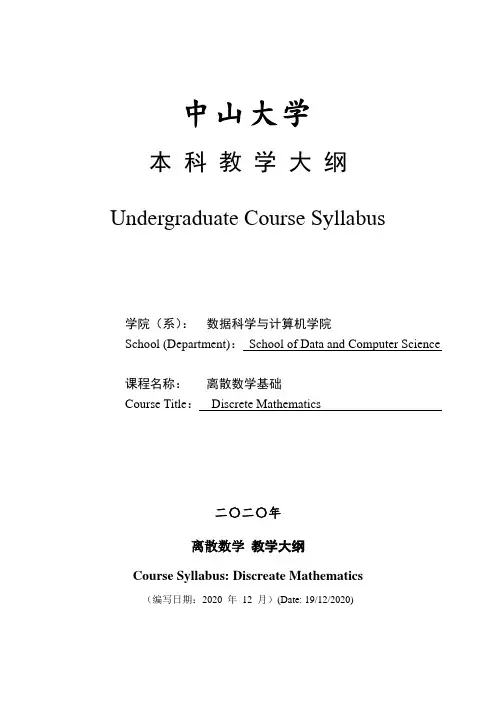
中山大学本科教学大纲Undergraduate Course Syllabus学院(系):数据科学与计算机学院School (Department):School of Data and Computer Science课程名称:离散数学基础Course Title:Discrete Mathematics二〇二〇年离散数学教学大纲Course Syllabus: Discreate Mathematics(编写日期:2020 年12 月)(Date: 19/12/2020)一、课程基本说明I. Basic Information二、课程基本内容 II. Course Content(一)课程内容i. Course Content1、逻辑与证明(22学时) Logic and Proofs (22 hours)1.1 命题逻辑的语法和语义(4学时) Propositional Logic (4 hours)命题的概念、命题逻辑联结词和复合命题,命题的真值表和命题运算的优先级,自然语言命题的符号化Propositional Logic, logic operators (negation, conjunction, disjunction, implication, bicondition), compound propositions, truth table, translating sentences into logic expressions1.2 命题公式等值演算(2学时) Logical Equivalences (2 hours)命题之间的关系、逻辑等值和逻辑蕴含,基本等值式,等值演算Logical equivalence, basic laws of logical equivalences, constructing new logical equivalences1.3 命题逻辑的推理理论(2学时)论断模式,论断的有效性及其证明,推理规则,命题逻辑中的基本推理规则(假言推理、假言易位、假言三段论、析取三段论、附加律、化简律、合取律),构造推理有效性的形式证明方法Argument forms, validity of arguments, inference rules, formal proofs1.4 谓词逻辑的语法和语义 (4学时) Predicates and Quantifiers (4 hours)命题逻辑的局限,个体与谓词、量词、全程量词与存在量词,自由变量与约束变量,谓词公式的真值,带量词的自然语言命题的符号化Limitations of propositional logic, individuals and predicates, quantifiers, the universal quantification and conjunction, the existential quantification and disjunction, free variables and bound variables, logic equivalences involving quantifiers, translating sentences into quantified expressions.1.4 谓词公式等值演算(2学时) Nested Quantifiers (2 hours)谓词公式之间的逻辑蕴含与逻辑等值,带嵌套量词的自然语言命题的符号化,嵌套量词与逻辑等值Understanding statements involving nested quantifiers, the order of quantifiers, translating sentences into logical expressions involving nested quantifiers, logical equivalences involving nested quantifiers.1.5谓词逻辑的推理规则和有效推理(4学时) Rules of Inference (4 hours)证明的基本含和证明的形式结构,带量词公式的推理规则(全程量词实例化、全程量词一般化、存在量词实例化、存在量词一般化),证明的构造Arguments, argument forms, validity of arguments, rules of inference for propositional logic (modus ponens, modus tollens, hypothetical syllogism, disjunctive syllogism, addition, simplication, conjunction), using rules of inference to build arguments, rules of inference for quantified statements (universal instantiation, universal generalization, existential instantiation, existential generalization)1.6 数学证明简介(2学时) Introduction to Proofs (2 hours)数学证明的相关术语、直接证明、通过逆反命题证明、反证法、证明中常见的错误Terminology of proofs, direct proofs, proof by contraposition, proof by contradiction, mistakes in proofs1.7 数学证明方法与策略初步(2学时) Proof Methods and Strategy (2 hours)穷举法、分情况证明、存在命题的证明、证明策略(前向与后向推理)Exhaustive proof, proof by cases, existence proofs, proof strategies (forward and backward reasoning)2、集合、函数和关系(18学时)Sets, Functions and Relations(18 hours)2.1 集合及其运算(3学时) Sets (3 hours)集合与元素、集合的表示、集合相等、文氏图、子集、幂集、笛卡尔积Set and its elements, set representations, set identities, Venn diagrams, subsets, power sets, Cartesian products.集合基本运算(并、交、补)、广义并与广义交、集合基本恒等式Unions, intersections, differences, complements, generalized unions and intersections, basic laws for set identities.2.2函数(3学时) Functions (3 hours)函数的定义、域和共域、像和原像、函数相等、单函数与满函数、函数逆与函数复合、函数图像Functions, domains and codomains, images and pre-images, function identity, one-to-one and onto functions, inverse functions and compositions of functions.2.3. 集合的基数(1学时)集合等势、有穷集、无穷集、可数集和不可数集Set equinumerous, finite set, infinite set, countable set, uncountable set.2.4 集合的归纳定义、归纳法和递归(3学时)Inductive sets, inductions and recursions (3 hours)自然数的归纳定义,自然数上的归纳法和递归函数;数学归纳法(第一数学归纳法)及应用举例、强归纳法(第二数学归纳法)及应用举例;集合一般归纳定义模式、结构归纳法和递归函数。
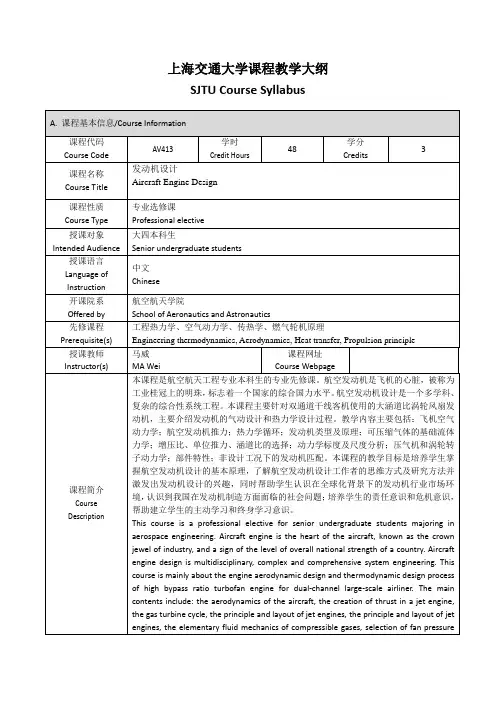
上海交通大学课程教学大纲SJTU Course SyllabusA 价值引领A1 坚定理想信念,践行社会主义核心价值观A2 厚植家国情怀,担当民族伟大复兴重任A3 立足行业领域,矢志成为国家栋梁A3.1 树立“奋发图强、空天报国”信念A4 追求真理,树立创造未来的远大目标A5 胸怀天下,以增进全人类福祉为己任。
B 知识探究B1 深厚的基础理论B2 扎实的专业核心B3 宽广的跨学科知识B4 领先的专业前沿B5 广博的通识教育B6.1 掌握本专业所需的数学、物理、电子、信息等基本理论知识和技能;B6.1.1 了解并理解专业学习所必需的数学、物理、电子及信息等相关知识;B6.1.2 掌握基础物理实验操作、电子及信息应用等基本技能;B6.1.3 掌握科学实验(研究)的基本的方法论。
B6.2 掌握完整的航空航天工程的基础知识体系,理解科学、工程、社会的关系,理解航空航天系统的复杂性,正确认识航空航天作为现代社会最尖端的技术之一的重要性和潜在的发展能力;B6.2.1 掌握航空航天的知识体系,包括航空航天概论、飞行力学、自动控制原理、飞行器控制、空气动力学、固体力学与结构、飞行器结构力学、工程热力学、推进原理、飞行器设计、发动机设计、航空安全与人为因素等内容;B6.2.2 掌握必要的控制、风洞、结构强度、叶轮机械等实验技能以及相关的实验数据处理和分析方法;B6.2.3 掌握一般工程设计、飞行器设计、发动机设计等设计方法,在具体的飞行器设计尝试中体会系统的复杂性以及如何协调各种设计指标。
C能力建设C1 审美与鉴赏能力C2 沟通协作与管理领导能力C3 批判性思维、实践与创新能力C4 跨文化沟通交流与全球胜任力C5 终身学习和自主学习能力C6 熟练运用各种现代媒体技术获取科学研究信息,包括英文信息的能力;C7 系统地掌握本专业的基本实验方法与技能,能够归纳、整理、分析实验结果C8 初步具备协调各种设计指标、进行飞行器系统设计的能力C9 具备较强的口头与书面表达能力,撰写学术论文和参与学术交流D人格养成D1 刻苦务实、意志坚强D2 努力拼搏,敢为人先D3 诚实守信,忠于职守D4 身心和谐、体魄强健D5 崇礼明德,仁爱宽容D6 通过学习职业道德和学术诚信标准并实践,初步养成良好的职业诚信素质D7 具备关于大型工程系统的复杂性的认识D8 具备关于社会因素和社会影响力在本专业中的重要性的认识D9 初步具备科学素养。
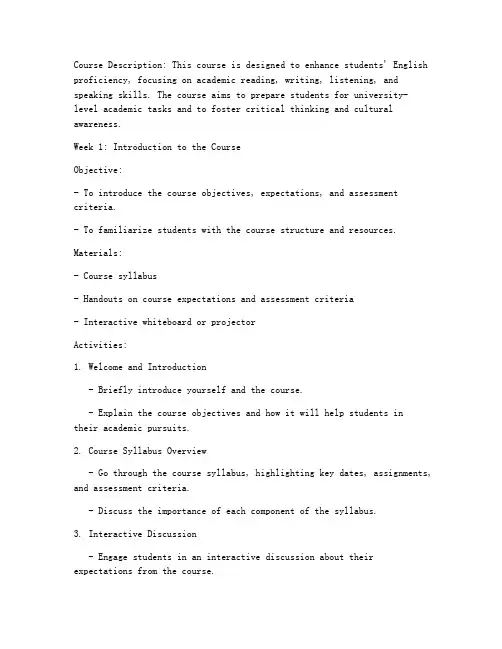
Course Description: This course is designed to enhance students' English proficiency, focusing on academic reading, writing, listening, and speaking skills. The course aims to prepare students for university-level academic tasks and to foster critical thinking and cultural awareness.Week 1: Introduction to the CourseObjective:- To introduce the course objectives, expectations, and assessment criteria.- To familiarize students with the course structure and resources.Materials:- Course syllabus- Handouts on course expectations and assessment criteria- Interactive whiteboard or projectorActivities:1. Welcome and Introduction- Briefly introduce yourself and the course.- Explain the course objectives and how it will help students intheir academic pursuits.2. Course Syllabus Overview- Go through the course syllabus, highlighting key dates, assignments, and assessment criteria.- Discuss the importance of each component of the syllabus.3. Interactive Discussion- Engage students in an interactive discussion about their expectations from the course.- Encourage them to share their goals and any concerns they might have.4. Resource Introduction- Introduce the library resources available for English language learning.- Discuss the importance of using online resources and academic databases.5. Homework Assignment- Assign a reading from the textbook to be completed before the next class.- Provide guidelines on how to approach the reading and what to look for.Homework:- Read the assigned text from the textbook.- Reflect on the text and prepare questions or observations for class discussion.Week 2: Academic ReadingObjective:- To develop students' academic reading skills.- To introduce strategies for comprehending and analyzing academic texts.Materials:- Academic reading text from the textbook- Highlighters and note-taking materialsActivities:1. Warm-Up Activity- Begin with a brief review of vocabulary from the previous week's homework.- Conduct a quick quiz to check understanding.2. Reading Strategies Introduction- Discuss different reading strategies such as skimming, scanning, and in-depth reading.- Provide examples of each strategy and demonstrate their use.3. Text Analysis- Distribute the academic reading text.- Guide students through the process of analyzing the text, focusing on main ideas, supporting details, and author's purpose.4. Group Discussion- Divide students into small groups and assign each group a section of the text to discuss.- Encourage students to summarize their findings and present them to the class.5. Homework Assignment- Assign a reflective writing task where students summarize the main points of the text and explain how they can apply the reading strategies learned in their academic work.Homework:- Write a summary of the assigned text, applying the reading strategies discussed in class.- Prepare to share your summary with the class.Week 3: Academic WritingObjective:- To introduce the basics of academic writing.- To develop students' writing skills, particularly essay writing.Materials:- Writing prompts- Essay writing guidelinesActivities:1. Writing Prompt Discussion- Introduce a writing prompt related to the course content.- Discuss the prompt with students, ensuring they understand the topic and requirements.2. Brainstorming Session- Guide students through a brainstorming session to generate ideas and outlines for their essays.- Encourage students to think critically and explore different perspectives.3. Essay Writing Workshop- Provide a step-by-step guide on how to structure an essay, including introduction, body paragraphs, and conclusion.- Demonstrate the writing process with a sample essay.4. Peer Review- Pair students up to review each other's essays, offering constructive feedback.- Discuss the importance of peer review and how to give effective feedback.5. Homework Assignment- Assign the writing of a short essay based on the writing prompt.- Provide guidelines on essay structure and the expectations for the assignment.Homework:- Write a short essay based on the provided writing prompt, following the essay structure guidelines.- Submit the essay for peer review.Continuation:- Each subsequent week will focus on a different aspect of English language skills, including listening, speaking, and further development of reading and writing skills. Activities will vary but will always aim to engage students in interactive and practical learning experiences.。
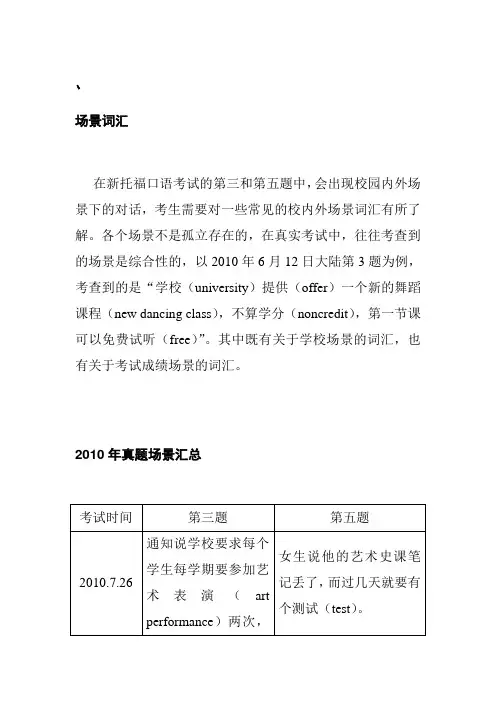
、场景词汇在新托福口语考试的第三和第五题中,会出现校园内外场景下的对话,考生需要对一些常见的校内外场景词汇有所了解。
各个场景不是孤立存在的,在真实考试中,往往考查到的场景是综合性的,以2010年6月12日大陆第3题为例,考查到的是“学校(university)提供(offer)一个新的舞蹈课程(new dancing class),不算学分(noncredit),第一节课可以免费试听(free)”。
其中既有关于学校场景的词汇,也有关于考试成绩场景的词汇。
2010年真题场景汇总一、学校场景(一)入学enroll v. 注册;登记enrollment n. 登记,注册,入学opening ceremony 开业典礼, 仪式orientation meeting开学说明会staff n. 全体职员faculty n. 教职员工freshman n. 四年制大学、学院的一年级学生sophomore n. 四年制大学、学院的二年级学生junior n. 四年制大学、学院的三年级学生senior n. 四年制大学、学院的四年级学生tuition n. 学费;费用fee n. 费用apply for scholarshipdecline 拒绝test n. 测试placement test 开学测试excellent adj. 出色的;优秀的;最佳的average adj. 平均的,一般的below average 低于平均水平的,差的(二)结构及称谓university- president n. 大学,校长chancellor n. 名誉校长college n. 学院school n. 学院dean n. 学院院长,系主任principal n. 中学校长professor n. 教授associate professor 副教授assistant n. 助理,助手assistant professor 助理教授coordinator n. 班主任,协调人counselor n. 辅导员advisor n. (大学的)指导老师instructor n. 讲师tutor n. 家庭教师;个人辅导;家教supervisor n. 管理人undergraduate n. 本科bachelor’s degreegraduate n. 研究生(三)建筑物building n. 建筑,建筑物administration building 行政大楼main building主楼wing/annex n. 配楼teaching building教学楼dorm/dormitory n. 宿舍auditorium n. 会堂,礼堂hall n. 大厅、礼堂assembly n.集合,集会computer lab 计算实验室,机房the concert hall 音乐厅the orchestra 管弦乐团(四)毕业及学位graduation n. 毕业commencement ceremony 毕业典礼convocation n. 正式会议,简单的毕业典礼commencement n. 毕业典礼日,学位授予典礼日cap and gown 毕业典礼时的服饰Bachelor’s degree 学士学位Master’s degree 硕士学位Doctoral degree 博士学位二、选课场景(一)选修与专业major n. 主修科目major in 主修;专攻minor n. 副修科目double major 双专业change for major 换专业exemption n. 免修academics n. 文化课(二)类型required/compulsory course 必修课requirement n. 必修课selective/optional course选修课elective course 选修课lecture n. 讲座;讲课,讲学scholar 学者seminar n. 高级研讨性课colloquium n.报告课tutorial n. 个人辅导课程workshop n. 专题课程(三)学科science n. 理科arts n. 文科engineering n. 工科,工程学mathematics n. 数学physics n.物理学chemistry n. 化学biology n. 生物学geography n. 地理学electronics n. 电子学computer science 计算机科学astronomy n. 天文学electronics engineering 电子工程学botany n. 植物学psychology n. 心理学zoology n. 动物学architecture n. 建筑学oceanography n. 海洋学ecology n. 生态学medical science 医学archaeology n. 考古学history n. 历史学linguistics n. 语言学pedagogies n. 教育学,教学法sociology n. 社会学anthropology n. 人类学economics n. 经济学statistics n .统计学accounting n .会计学philosophy n. 哲学(四)级别introductory adj. 引导的,开端的introductory course 预备课程,导论课,入门课elementary/fundamental adj. 初级的intermediate/secondary adj. 中级的advanced adj. 高级的prerequisite n. 先修课程;先决条件,前提三、上课场景(一)上课sign up for 注册(某一科目)register course n. 科目,课程tuition fees 学费attend class 上课miss class 缺课,错过skip class逃课textbook n. 课本,教材required textbook 要求的课本attendance n. 出勤,出席人数,到场次数grading system 打分体系participation n. 参与,分享class participation 课堂参与(二)教学semester n. (尤指美国中学和大学的)一学期,半学年semestral adj. 学期的term n. 学期,专业术语quarter n. 小学期handout n. 散发的印刷品,材料,讲义course guideline 课程纲要syllabus n. 教学大纲signature n. 签字,签名p rofessor’s signature 教授的签字(用于注册课程)course cap课程容量,可以招收的学生数openings n. 可供注册的名额take v.选(课)drop v. 退(课)Drop/Add form 课程变更申请表late registration晚注册deregistration n. 注销take a leave 休学,请假(三)教师称谓professor n. 教授lecturer = instructor n. 讲师teaching assistant = TA 助教research assistant = RA 助研counselor/adviser n. 咨询者,顾问president n. 大学校长teacher/faculty n. 教师student's advisor 学生顾问physicist n. 物理学家mathematician n. 数学家chemist n. 化学家historian n. 历史学家statistician n. 统计学家四、缺课场景skip class 缺课oversleep v. 睡过头have trouble waking up 睡不醒car breaks down 车坏了car coul dn’t start车无法开动doesn’t work不启动does n’t feel well感觉不舒服catch a cold 感冒have a temperature 发烧miss the school bus 错过校车does n’t catch a bus没赶上车something urgent/emergent to do 有更多紧急的事要做五、作业场景assign v. 分配;指派;布置作业assigned adj. 被分配的,被指定的assignment n. 作业homework/ coursework/ schoolwork/ studies n. 作业lab report 实验报告book report 读书报告oral report 口头报告project n. 作业presentation n. 发言academic journal n. 学术期刊social investigation 社会调查survey n. 调查questionnaire n. 调查表,调查问卷observation n.观察interview n./ v. 采访take note 记笔记plagiarism n. 抄袭speech n. 演讲presentation n. 演讲,陈述eye contact 目光接触intonation n. 音调六、论文场景(一)论文名称term paper 学期论文,期末论文research paper 研究论文thesis/essay/dissertation n. 论文(二)论文步骤data n. 资料,材料,数据collect data 收集数据data analysisoutline n. 大纲,提纲,概要;勾画,勾勒bibliography n书目, 参考书目reference n. 参考资料;参考书(三)论文提交submit v. 递交,呈递turn in 上交,交还hand in 交上,递交hand out 分发,给予due date/time 期限,到期日deadline n. 最终期限;截止时间extension n. 延期;延长(四)论文完成情况1.内容宽泛broad adj. (论文等)内容宽泛have trouble deciding on a topic 选题困难narrow down 使……变窄,(论文等)缩小范围focus 集中,聚焦main point 主要问题,要点main topic 母题subtopic 小标题;要点2.参考资料source n. (写论文的)参考资料too much material to covertons of material to readhave all sorts of trouble3.批判思维critical adj. 批判的,批评的critical thinking 批判性思维lack n./v. 不足,缺少lack one’s own ideas缺少某人自己的想法4.修改润色polish v. 润色correct v. 纠正,修正,更正redesign v. 重新设计,修改设计revise v. 修改rewrite v. 重写final draft 完成稿七、考试场景(一)考试类型midterm exam 期中考试final exams (= finals)期末考试cumulative final 总结性考试take-home exam拿回家的开卷考试(一般有限定的时间)open-book exam 开卷考试subjective test 主观性测试objective test 客观性测试(multiple-choice)pop quiz 突击考试,抽查式测验blue book 答题本assessment n估价; evaluationappraisal n.评价, 估价make up (for) 补考make-up test 补考resit/ retake v. 重考(二)难度supposed to be easy, but…本以为(考试)很就黯淡turn out to be very difficult (考试)很难next to impossible to get A…拿到A是不可能的(三)复习go over 检查,重做,复习go through 检查,浏览review n./v. 复习,回顾cram for the exam 突击考试stay up 熬夜(四)考试安排exam schedule 考试安排secretary n. 写字台book a room 预定房间invigilator n. 监考,监视器proctor n. 代理人,学监sign up 签字参加bulletin board 告示牌draft n. 草稿faculty lounge 教员室draw up 起草,拟定final schedule 最终计划,最后时间表do it manually 手动完成complex adj. 复杂的,复合的,合成的n. 复合体,综合体clash with不调和,与……冲突consult v. 商讨,向……请教,查阅(五)考试成绩transcript n. 成绩单score sheetgrade report 成绩单grade n. 学分GPA(grade point average) 平均积分点Required courses; optional coursescredit n. 学分mark n. 分数score n. 分数perfect grade 优异成绩low grade 低分high mark 高分ace v. 考得好passing grade 及格分fail v. 不及格;失败failing grade 不及格分full marks 满分straight A's 全是Abe all A's and B's 全是A和BA minus A减B plus B加B minus B减flunk n. 不及格,失败v.(使)失败,(使)考试不及格pass the exam with flying colors 以优异成绩通过考试graduate with honors 以荣誉毕业diploma n. 毕业证书,学位证书,文凭degree n. 学位certificate n. 证书八、图书馆场景(一)管理library n. 图书馆librarian n. 图书管理员counter n. (图书馆)柜台interlibrary service 馆际服务(二)部门设置information desk 服务台delivery/circulation desk借书处return area 还书处reference room 资料室students locker 学生存储间periodical reading room 期刊阅览室study lounge 自习室(三)借书或者检索的流程catalogue n. 目录book catalogue 图书目录classified catalogue 分类目录bibliography n. 参考书目,文献学title index 书目索引alphabetic index 按字母顺序排列的索引library card 借书证unreturned adj. 未归还的,为返还的fine n. 罚金,罚款overdue fine 过期罚金check out 办理(借、还)手续renew v. 续借overdue v. 过期(四)书籍阅览publication n. 出版物,出版,发行periodical n. 期刊;定期发行物reading n. 阅读magazine n. 杂志reserved books 馆藏书(只能在图书馆内借阅)online journal 在线期刊video tape 录像带back issue 过期杂志current issue 近期杂志archive n. 档案non-fiction n. 非小说类文学作品science-fiction n. 科幻小说reference section 参考书部(五)去图书馆自习backpack n.双肩背包v.背ride a bike 骑车laptop n. 笔记本电脑a load of books 大量书籍pretty far away 相当远crowded adj. 拥挤的comfortable adj. 舒适的,充裕的comfy (口语词)舒服的,轻松的=comfortable (六)计算机房copier n. 复印机shelf n.书架photocopy room复印室lab rules计算机室规程printer n. 打印机fax machine传真机Macintosh苹果计算机hardware n. 硬件software n. 软件network n. 网络access to the net访问网络floppy disk软盘hard disk硬盘CD-ROM光盘驱动器monitor n. 监视器keyboard n. 键盘mouse device鼠标modem n. 调制解调器setup n. 安装uninstall v. 卸载Operation System操作系统program n. 程序word/data processing 文字/数据处理user n. 用户click v. 点击update v. 更新database n. 数据库manual n. 指南menu n. 菜单password n. 口令virus n. 病毒web page网页website n. 网站online adj. 在线的E-mail 电子邮件firewall n. 防火墙log on登录九、科研场景hypothesis n. 假说alternative hypothesis择一假说null hypothesis无效假说, 零假说survey, questionnaire n. 调查mini-survey 小范围的调查experiment n. 实验,试验observation n. 观察,评论collect data for papers 为论文收集资料analyze v. 分析analyze data 分析数据interpret v. 解释interpret data 解释数据interpretation n. 解释,说明analysis n. 分析analytical adj. 分析的subject n. 科目;主题;话题;题材;对象sample n. 样本treatment group 控制组non-treatment 非控制组control group 控件组,对照组十、奖学金场景a letter of reference调查信,保证书,推荐人的信a letter of recommendation 推荐信financial aid经济援助、经济资助honor roll 红榜;优秀学生名单scholarship n. 奖学金fellowship n. 奖学金stipend n. 薪金;奖学金teaching assistantship 助教奖学金research assistantship 研究奖学金grant n. 助学金tuition waive 学费减免loan n. 贷款need-based adj. 以需求为基础merit-based adj. 以优秀为基础十一、学生活动场景(一)驾驶与停车parking area 停车区域designated parking area 指定停车地点reserved parking area 预留的停车位parking permit 停车证parking sticker停车许可标签parking meter 汽车停放计时器,汽车停放收费器parking in the wrong place 停错地方parking ticket 违规停车罚单shuttle bus 班车truck n. 卡车cut off 削减(二)食堂dining hall 食堂canteen n. 餐厅cafeteria n. 自助餐厅或食堂meal plan 餐券large-screen TV 大屏幕电视(三)文艺art performance 艺术活动concert n. 音乐会opera n. 歌剧dancing n. 舞蹈dancer n. 舞者literature n. 文学play n. 话剧screen n. 银幕poetry n. 诗歌poetic adj. 诗意的,诗的handcraft n. 手工艺品sculpture n. 雕塑(四)校内外活动club n. 俱乐部club manager 俱乐部管理人natural club 自然俱乐部hiking n. 徒步旅行student center 学生中心stain v. 弄脏party n. 派对gym n. 健身房,体育馆insurance premium 保险费priority n. 优先权reissue a student ID card 补办学生证student union 学生会extracurricular adj. 课程以外的student center 学生活动中心membership n. 成员资格student health center 学生卫生所student medical insurance 学生医疗保险verify v. 查证,核实十二、工作场景(一)身份与职务full-time adj. 全职的full-time job 全职part-time adj. 兼职的part-time job 兼职waiter n. 侍者,(男)服务员waitress n. 女侍者,女服务员babysitter n. 临时保姆work at the library 图书管理员工作(二)求职与招聘apply for a job 求职,找工作position desired/wanted 期望职位career objective 职业目标occupational career 职业生涯competitive adj. 竞争的benefit future career 对将来的职业生涯有益working experience 工作经历qualification n. 资格,限定qualified adj. 合格的resume n. 简历CV(curriculum vitae) 履历career n. 职业,事业career placement center 职业介绍所career service职业性工作人员,长期服务vocational education 职业教育career fair 招聘会job fair 招聘会job posting 招聘广告(三)工作与管理accomplish v. 完成(任务等)responsibility n. 职责personnel management 人事管理casual leave 例假;事假sick leave 病假office hours 办公时间day shift 日班night shift 夜班day off 休息日wage n. 工资salary n. 工资systematize v. 使系统化conduct v. 经营,处理rival n. 竞争对手undertake v. 承担(四)工作状态tough adj. 艰苦的,棘手的stressed adj. 紧张的,有压力的stressful adj. 紧张的,压力重的pressure n. 压力dread n. 恐惧,可怕adj. 可怕的,可怖的v. 恐惧,害怕dread something 害怕做某事have a dread of 害怕run out of 用完,耗尽cram v. 塞满,填满,仓促备考n. 仓促备考,挤成一堆的人群gamble v. 赌博,投机,孤注一掷n. 赌博,冒险quit 放弃give up 放弃enjoy v. 享受,喜欢fun n. 乐趣adj. 有趣的v. 开玩笑balance n./v. 平衡,均衡energy n. 能量,精力tired adj. 疲劳的,疲倦的,累的next to impossible 几乎不可能的consolation n. 安慰,慰藉get through 结束,做完,通过,到达bite the bullet 咬紧牙关,忍受痛苦(五)实习archaeology n. 考古学dig v. 挖掘endangered adj. 濒于灭绝的excavation n. 发掘,挖掘expedition n. 考察,考察队field trip (学生的)校外考察旅行field research实际教学,现场调查研究habitat n. 栖息地restore v. 重建,恢复site n. 场所specimen n. 标本vegetation n. 植物,草木十三、住宿场景(一)类型off campus housing 校外居住on campus housing 住校accommodation n.住处, 膳宿housing n. 住处dorm/dormitory n. 宿舍residence hall宿舍suite n. 套间deluxe suite 豪华套间studio n. 工作室,独立套间village n. 村落(校内一栋一栋的房子,可以用做宿舍)lounge n.公共大厅(可以用做娱乐)homestay n. 客居外国家庭corridor n. 走廊,过道,(二)租房lease n.租借, 租约rent n. 租金v. 租用security deposit 押金,押租share n./v. 共有,共享patio n. 阳台sliding door推拉门vacancy n. 空房间single room 单人房double room 双人房twin room 双人房two-bedroom apartment house key 房锁匙move in 搬进去move out 搬出去(三)人物custodian n. 管理人landlord n. 房东landlady n. 女房东resident n. 居民inhabitant n. 居民roommate n. 同屋者,室友tenant n. 房客(四)手续流程company n. 陪伴,同伴v. 陪伴intend v. 想要,打算arrival n. 到来,到达departure n. 启程,离开,出发book v. 预定,定offer v. 提出,提供provide with 提供discount n./v. 折扣receive v. 接待,接见registration n. 登记,注册registration form 登记表arrange v. 安排,准备;整理,布置check in 入住登记check out 办理退房手续cancel v. 取消key card 出入证identification n. 身份证明room number 房间号,啊room key 房间钥匙(五)床上用品pillow n.枕头bed linen 床上用品sheet n. 被单mattress n.床垫blanket n.毯子towel n.手巾, 毛巾quilt n.棉被(六)电器类appliance n. 家用电器electric appliance/instrument/equipment 电器heater n. 加热器furnace n. 炉子heating unit 暖气片air conditioner 空调(设备)stove n. 炉子microwave oven 微波炉washer n. 洗衣机washing machine 洗衣机dryer n. 烘干机utensil n. 器皿;用具kitchen utensil 炊具oven n. 烤箱;烤炉range n. 煤气灶dishwasher n. 洗碟机(hot-water) heater n. 热水器coffeepot n. 咖啡壶refrigerator (freezer) n. 冰箱vacuum cleaner 吸尘器tape player 录音机CD player CD机laundry n. 洗衣店laundromat n. 自动洗衣店maintenance n. 维修,保养(七)家具类furniture n. 家具bookshelf n. 书架bookcase n. 书柜couch n. 沙发chest n. 柜子;橱;箱子dresser (bureau) n. 梳妆台cabinet n. (电视机等)机箱;储藏柜;陈列柜cupboard (closet) n. 碗橱storage wall 壁橱rug n. 小地毯carpet n. 地毯curtain n. 窗帘bathtub n. 浴缸fix v. 固定;确定fixture n. (房屋)固定装置furnishings n. 室内陈设(八)日常生活personal possessions/property/belongings 个人财产garbage/rubbish/waste n.垃圾dispose v. 处理gas meter煤气表insect n.昆虫burglar n.夜贼leaking/leakage n. 泄漏lost adj. 遗失的lost key丢钥匙break in 闯入drainage system 排水系统,排水管系。
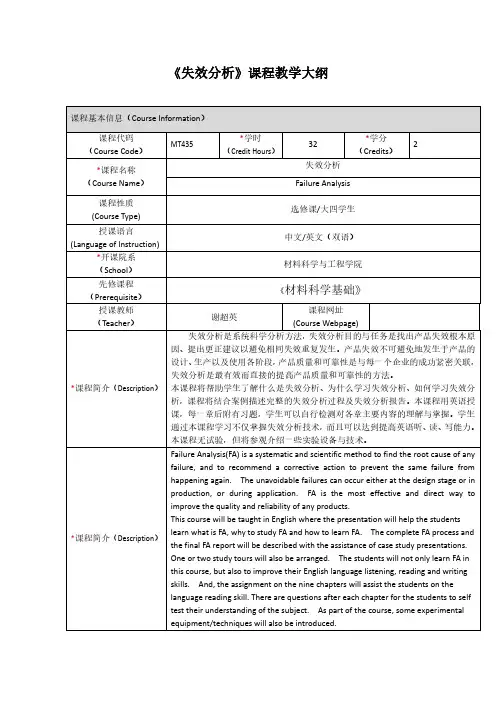
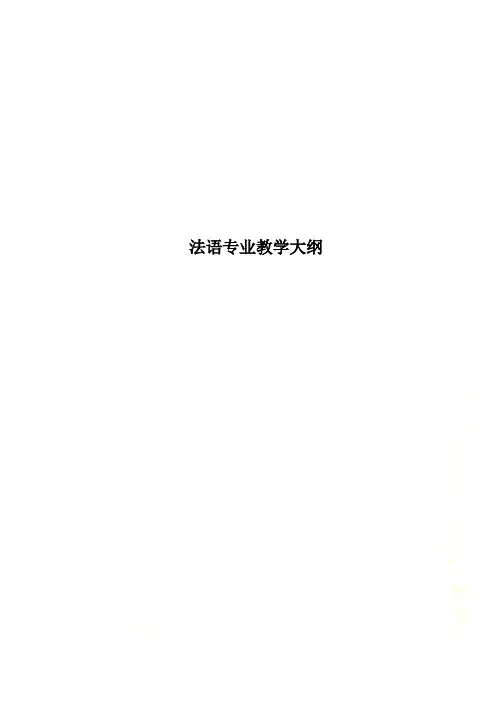
法语专业教学大纲浙江工商大学外国语学院法语专业教学大纲Course Syllabus forFrench Majors(2011年12月修订)法语专业教学大纲1法语语法2基础法语(一)3基础法语(二)4基础法语(三)5基础法语(四)6法语听说(一)7法语听说(二)8法语听说(三)9法语听说(四)10法语泛读(一)11法语泛读(二)12法语写作13法语笔译14法语口译15高级法语(一)16高级法语(二)17法国文学18法语语言学概论19法国报刊选读20法国概况21法国社会与文化22法语电影赏析23简明法国历史(一)24简明法国历史(二)25国际贸易地理26企业法语27法国经济28旅游实务法语29国际商贸法语30学术论文写作31英语口语32综合(中级)英语33高级英语法语语法课程法文名称:La grammaire française课程代码:0723612学分:2 总学时:32授课对象:本科法语专业二年级学生开课学期:第一学期考试方式:闭卷一、课程性质“法语语法”系法语专业选修课程,在法语专业的第二学年第一学期开设。
二、教学目的与要求1. 教学目的《高等学校法语专业基础阶段教学大纲》规定:基础阶段的教学目的在于使学生掌握具有听说读写的基本技能和一定的交际能力。
培养学生具备以上基本语言技能。
在配合基础法语课程的前提下,配套设置语法协同进程的课程,在巩固已学到的语法知识的基础上,适当深化相关基础语法知识,达到温故而知新的效果,使得学生为今后的高阶段法语学习打下良实的语言基础,并为大二阶段的专业四级考试起到良好的促进作用。
2. 教学要求本课程的对象是法语专业二年级学生。
要求熟记所学的基本语法规则,概念清楚无误,能够熟练灵活运用各种语法规则;能够独立理解分析较长较难的长句或语言现象。
三、课程内容与学时安排(共32个学时)课程内容讲授及练习课时1.VERBES : savoire et2connaître; pouvoir,vouloir,devoir2. ARTICLES VOIX 22. LE COMPARATIFDE L’ADJECTIF2 1. LE COMPARATIF del’adverbe2. L’ADJECTIF2 LE SUPERLATIF DES ADJECTIFS ET DES ADVERBESPRONOM (I) : sujet ;2 tonique ; neutre ;complément2 PRONOM (II) : possesssif ; indéfini ;relatifL’INDICATIF (I) :2 présent ; les temps dupassé1. L’INDICATIF (II) : les2 temps du futur2. L’IMPERATIF21. LE GERONTIF2. LE PARTICIPEPASSE et PRESENT1. L’INFINITIF22. Faire / Laisser inf.1. Les négations2particulières2. Les discours indirectsLE CONDITIONNEL 2LE SUBJONCTIF 21. L’EXPRESSION DE2LA CAUSE2. L’EXPRESSION DELA CONSEQUENCE3. L’EXPRESSION DELA COMPARAISON1. La SITUATION dans2le TEMPS2. Les EXPRESSIONSDE TEMPSEpreuve/Révision 2合计32四、教学原则与方法整个教学过程中注意培养独立分析和解决问题的能力,巩固基本语法知识,坚持语言基本功的训练。
一、名词解释在语言学领域,syllabus(音译:“西拉巴斯”)是一个常见的名词,它指的是在一门课程中涉及的所有教材、教学安排和学习目标等内容的总称。
在学术上,syllabus一般由教师或教育机构根据学科要求和教学需要进行设计,并在课程开始前向学生提供。
二、语言学中的syllabus1. 定义和作用在语言学中,syllabus主要指的是用于教授语言课程的教学大纲。
它包含了课程内容的整体安排、学习目标的设定、教学方式和评估方法等信息,是教师和学生在进行语言学习时的重要参考依据。
通过syllabus,教师可以清晰地将课程的目标和内容传达给学生,帮助学生了解课程的整体架构和学习重点,从而更好地进行学习和备考。
2. 课程内容和安排在语言学中,syllabus通常会包含课程的各个学习模块或单元的主题、教学内容和学习时间安排等信息。
在英语课程的syllabus中,可能会包括词汇、语法、听说读写等技能的学习模块、每个模块所涉及的具体内容和教学方法、以及每周课程的安排和作业要求等。
3. 学习目标和评估方式另外,在语言学的syllabus中,通常也会明确列出每个学习模块或单元的学习目标,以及学生的评估方式和标准。
这有助于教师和学生清晰地了解在课程学习过程中要达到的目标和要求,以及如何进行学习效果的评估和监控。
这种明确的学习目标和评估方式有助于提高教学的针对性和学生的学习动力,从而更好地促进语言学习的效果。
4. 教学方式和教学资源在语言学中的syllabus中通常也会包括教学方式和所需的教学资源等信息。
课程中可能采用的教学方法、学生需要使用的教材和参考书目、以及教师提供的学习资源和支持等。
这有助于学生和教师了解在课程学习过程中所需的教学资源和协助,并为教学和学习提供了更好的保障。
三、结语syllabus在语言学中被广泛应用,它不仅是教师进行课程设计和教学安排的重要工具,也是学生进行学习和备考的重要参考资料。
通过syllabus的制定和使用,可以更好地促进语言学习的有效进行,提高教学和学习的效果。
《综合商务英语Ⅰ》课程教学大纲Course syllabus of Business English: An IntegratedCourse Ⅰ一、课程基本信息Course Information课程代码: 16068004Course Code: 16068004课程名称:综合商务英语ⅠCourse Name: Business English: An Integrated Course Ⅰ课程类别:专业必修课Course Type: Compulsory学时:60学时Course Period: 60 hours学分:4学分Course Credit: 4适用对象: 商务英语专业1年级学生Students: First year undergraduate考核方式:考试Assessment: Examination先修课程:无Preparatory Course: None2、课程简介Course Introduction综合商务英语Ⅰ是为商务英语专业学生开设的1门专业技能必修课。
课程所选教材《商务英语综合教程》(第二版)是我国商务英语专业第1套按商务英语专业教学要求编写的教材,由对外经济贸易大学和上海外语教育出版社共同编写。
商务英语综合教程强调语言、文化与商务3者的有机结合,整套教材分为4册,1-4册中的语言技能、商务知识、文化知识按比例合理分配,第1册中的分配比例为,语言70%,商务与文化30%。
《商务英语综合教程Ⅰ》共有8个单元,其中每个单元包括围绕1个话题的3篇课文和配套视频资料。
每个单元的大体结构如下:第1部分:准备(词汇、内容、知识),第2部分:课文Ⅰ(课文理解检查),第3部分:课文II(阅读理解练习、视听练习等),第4部分:课文III:(语言练习与小组作业),第5部分:语言训练(语言点、理解练习、学习技能、写作技能)。
The undergraduate course Integrated Business English prepares students to play an active and creative role in today’s globalized world by exploring English languageand Business across cultures. The course bookBusiness English: An Integrated Course Book 1 constructs 8 topics for the whole semester, each containing 3 articles with language skill practices and in class discussions.3、课程性质与教学目的综合商务英语是1门专业技能必修课,是为商务英语专业开设的1门基础阶段主干课程。
COURSE SYLLABUS Qualitative Research for Education: Theory and MethodsFall 2008Instructor:Professor Ling LiCollege of EducationSouthwest UniversityOffice hours in TJB Building #219 by appointment lingli2@I. Course DescriptionII. Course ObjectivesIII. Course Textbook and Readings IV. Course RequirementsV. EvaluationVI. Course Outline and SchedulesEducation research is a complex endeavor involving several different methodological approaches. This course focuses on one kind of approach: qualitative methods. Qualitative research has a different tradition and founding theories from quantitative research, and the two modes of methodology are mutually complementary. This course includes two modules. The first module focuses on an introduction and inquiry into the theories and methodologies of qualitative research. And the second module will present a series of qualitative research projects to show how qualitative research is done in specific cases.The first module is divided into seven sections. (1) Origins, development and theoretical underpinnings, which will cover Chicago Sociology, the Sociology of Education, European connections and the Social Movement, and many other political, ideological and social events that promoted the development of qualitative research, and cover theories such as phenomenology, symbolic interaction, feminism and postmodernism. (2) Research design, which will introduce the designing of different types of qualitative research such as case studies and multi-site studies. (3) Field work, including issues and challenges for access, cultural, political and emotional issues in the field and approaches of doing fieldwork like interview and tape recording. (4) Collection of qualitative data, introducing approaches of data collection such as field notes, transcripts, photography, documents and others. (5) Data analysis and interpretation, focusing on data category, the coding system, and interpretation. (6) Writing process, which touches the decisions to be made in the process, and what a good qualitative research writing is like. (7) Application in education, covering evaluation and policy research, action research and others. In this module, the major forms of instruction will be lectures based on the course text. Also, students are required to read lists of reading materials, relevant to the section topics. Based on their personal understanding of the lecture and readings, and on the real issues that they come across in doing qualitative research projects, student groups are requested to give 30-minute presentations on the following weeks after each lecture, and they are responsible for leading the class discussion about the topics and their presentations. In this way, the course aims to enhance and ensure students’ real acquisition of the knowledge and theories of the qualitative research methodology.The second module will focus on the real practice and application of qualitative research methods. It includes a series of qualitative research projects presentations given by two students, the course instructor, and several professional scholars from Canada and the US, who are specialized in qualitative research methods, via long-distant internet videos. Apart from the theories of qualitative research, this course is intended as a practice for conducting fieldwork and applying techniques to researching and analyzing educational phenomena on a practical setting. Therefore, the second module, on the basis of the first, attempts to make students really involved in the real context of qualitative research and to make them learn by doing it themselves and learn by viewing how others are doing it. The long-distant lectures by the international professors aim to contribute international perspectives for students to view and understand qualitative research in different cultures.1.Develop a basic understanding of the theoretical orientations that underliequalitative methods in education.2.Understand the kinds of questions which have been and can be addressed withqualitative research.3.Understand the features and procedures in qualitative research methods andapproaches.4.Know how to formulate a viable research question independently.5.Learn about and practice qualitative data collection methods.6.Learn and practice qualitative data analysis and interpretation.7.Know how to prepare and conduct a research project8.Begin work on a small research project in the field, requiring the use ofqualitative data collection and analysis methods.9.Prepare and write a qualitative research proposal/paper/report/thesisIII. Course Textbook and ReadingsRequired TextBogdan, R.C. & Biklen, S.K. (2006). Qualitative research for education: An introduction to theory and methods. (5th edition.). Boston: Pearson.Other Required ReadingsCreswell, J.W. (2004). Educational research: Planning, conducting, and evaluating quantitative and qualitative research. (2nd edition.). Upper Saddle River, NJ:Merrill Prentice Hall.Li, L. (2008). Constructing teacher’s professional identity in China and Canada:Life stories in context. Saarbrucken, Germany: VDM Verlag Dr. MüllerAktiengesellschaft & Co. KG.Li, L. & Niyozov, S. (2008). Negotiating teacher's professional identity in a changing Chinese society. Education and Society, 26 (2), 69-84.Li, L. (2006). Constructing professional identity through narrative inquiry into educational experiences of four generations of women in my family. Paperpresented at The 2006 Annual Meeting of the Canadian Society for the Study of Education, in Toronto, Canada.Maxwell, J.A. (1996). Qualitative research design: An interactive approach.Thousand Oaks, CA: Sage Publications.Maxwell, J.A. (2004). Qualitative research design. (2nd edition.). Sage publications. Miles, M. & Huberman, A.M. (1994). Qualitative data analysis. (2nd edition.). Sage publications.Strauss, A. & Corbin, J. (2008). Basics of qualitative research: Techniques and procedures for developing grounded theory. (3rd edition.). Sage publications. (see more in VI. Course outline and schedules)Classes will be a combination of instructor lectures, student-led discussions on lectures and readings, student collaborative presentations, and finally practice project presentations. In addition to class participation, students are required to complete assignments and a final course paper using what will be learned through the course and in the practice. Students who are going to use qualitative research as methods in the graduation thesis will be required to submit thesis proposal and draft accordingly.(1) Class Participation (10%). Students will be expected to attend all the lecturesand contribute to class discussion. Students are encouraged to proposequestions and opinions related to the instructor’s lectures, preparation of theclass and required reading materials. Students should participate and interactactively with the lecturer’s and other classmates’ presentations(2) Weekly Presentation (30%). Students will be divided into seven groups, withfour or five in each group. The groups will be expected to give a 30 minutecollaborative presentations of their work concerning a topic related to theprevious lecture theme. Presentations will pertain to the additional readingsfor the previous week lecture and should come to class prepared to leaddiscussion and critique about the readings of that topic.(3) Research Paper (60%). This is the main requirement for the course. The paperwill serve as an important exercise in how to design an educational researchproject using qualitative research methods and based on fieldwork. For thosewho plan to conduct empirical research in their graduation thesis, this papercan be replaced by a thesis proposal or even the thesis draft. Students shouldconsult with instructor about the research question at some point during thesemester and begin the development of a conceptual framework for aqualitative research study as soon during the process of the course.V. EvaluationGrading Policy:Students will receive a grade for their class participation (10% of the final grade), group presentation (30%) and the final paper (60%).VI. Course outline and scheduleWeek 1: Course orientation1. What the course is about?2. What you will learn?3. What you will do?4. What we will read?5. How I will grade?6. What is “Qualitative Research”?7. The difference between qualitative and quantitative research8. What you will be able to do after the course?9. DiscussionWeek 2: Foundations of Qualitative Research for Education1. Characteristics of Qualitative Research2. Traditions of Qualitative Research2.1 Disciplinary Traditions2.2 Chicago Sociology2.3 The Sociology of Education2.4 European Connections and the Social Movement2.5 Ideological and Political Practices2.6 Ideologies and Social Change2.7 Politics and Theory in the Academy3. Theoretical Underpinnings3.1 Phenomenological Approach3.2 Symbolic Interaction3.3 A Story3.4 Culture3.5 Ethno-methodology3.6 The Current Theoretical Scene: Cultural Studies, Feminism,Postmodernism,3.7 Critical theory and Institutional Ethnography3.8 On Methods and MethodologyWeek 3: Student-led Presentation and DiscussionAdditional readings:Bruner, J. (1990). Acts of meaning. Cambridge, MA: Harvard University Press. Denzin, N. K., & Lincoln, Y. S. (1994). Handbook of qualitative research. Thousand Oaks, CA: Sage.Denzin, N. K., & Lincoln, Y. S. (2000). Handbook of qualitative research (2nd edition). Thousand Oaks, CA: Sage.Denzin, N. K., & Lincoln, Y. S. (2004). Handbook of qualitative research (3rd edition). Thousand Oaks, CA: Sage.Gadamer, H. (1975). Truth and method. New York: The Seabury Press.Husserl, E. (1965). Phenomenology and the crisis of Philosophy. New York: Harper Torchbooks.Mills, C. W. (1970). The sociological imagination. Harmondsworth: Penguin.Ryle, G. (1949). The concept of mind. Harmondsworth: Penguin Books Ltd.Week 4: Research Design1. Choosing a Study2. Case Studies2.1 Historical Organizational Case Studies2.2 Observational Case Studies2.3 Life History2.4 Documents2.5 Other Forms of Case Studies2.6 Case-study Design Issues2.7 Multi-case Studies3. Multisite Studies3.1 Modified Analytic Induction3.2 The Constant Comparative Method3.3 Multi-Site Ethnography4. Additional Issues Related to Design4.1 Proposal Writing4.2 Interview Schedules and Observer Guides4.3 Team Research and the Lone Ranger4.4 Qualitative Research and Historical ResearchWeek 5: Student-led Presentation and DiscussionAdditional readings:Cole, A. L., & Knowles, J. G. (2001). Lives in context: The art of life history research.Walnut Creek, CA: AltaMira Press.Gubrium, J. F., & Holstein, J. A. (Eds.) (2001). Handbook of interview research: Context and methods. Thousand Oaks, CA: Sage.Heshusius, L. (1994). Freeing ourselves from objectivity: Managing subjectivity or turning toward a participatory mode of consciousness. Education Researcher,23(3). 15-22King, T. (2003). The truth about stories: A native narrative. Toronto, ON: House of Anansi Press.Lawrence-Lightfoot, S., &Davis, J. H. (1997). The art and science of portraiture. San Francisco, CA: Jossey-Bass Publishers, Ch. 3.Merriam, S. B. (1988). Case study research in education: A qualitative approach. San Francisco, CA: Jossey-Bass, Ch. 5.Sparkes, A. (1994).Life histories and the issue of voice: Reflections on an emerging relationship. Qualitative Studies in Education, 7(2), 165-183.Week 6: Fieldwork1. Gaining Access2. First Days in the Fields3. The Participant/Observer Continuum4. Doing Fieldwork in Another Culture5. Research Characteristics and Special Problem with Rapport6. Be Discreet7. Researching in Politically Charged and Conflict-Ridden Settings8. Feelings9. Interviewing9.1 Focus Groups9.2 Audio Recording10.Visual Recording and Fieldwork11.Triangulation12.Leaving the FieldWeek 7: Student-led Presentation and DiscussionAdditional readings:Morgan, D. L. (2001). Focus group interviewing. In J. F. Gubrium & J. A. Holstein (Eds.) Handbook of interview research: Context and methods. Thousand Oaks, CA: Sage.Schram, T. H. (2003). Conceptualizing qualitative inquiry: Mindwork for fieldwork in education and the social sciences. Upper Saddle River, NJ/Columbus, OH:Merrill Prentice Hall.Burgess, R. G. (1989). Grey areas: Ethical dilemmas in educational ethnography. In R.G. Burgess (Ed.). The ethics of educational research. Barcombe, Lewes, EastSussex: Falmer Press.Kvale, S. (1996). Ethical issues in interview inquires. InterViews. Thousand Oaks, CA: Sage, Ch. 6.Phtiaka, H. (1994). What’s in it for us? Qualitative Studies in Education, 7(2), 155-164.Riddell, S. (1989). Exploiting the exploited: The ethics of feminist educational research. In R. G. Burgess (Ed.). The ethics of educational research. Barcombe, Lewes, East Sussex: Falmer Press.Week 8: Qualitative Data1. Some Friendly Advice2. Fieldnotes2.1 The content of fieldnotes2.2 The Form of Fieldnotes3. The Process of Writing Fieldnotes4. Transcripts from Taped Interviews4.1 The Form of Transcripts4.2 Recording Equipment5. Documents5.1 Personal Documents5.2 Official Documents5.3 Popular culture documents6. Photography6.1 Found photographs6.2 Research-Produced Photographs6.3 Photographs as Analysis6.4 Technique and Equipment7. Official Statistics and Other Quantitative Data8. Concluding RemarksWeek 9: Student-led Presentation and DiscussionAdditional readings:Hill, M.R. (1993). Archival Strategies and Techniques. Newbury Park: Sage Publications.Jupp, V. (1996). Documents and Critical Research. In Roger Sapsford and Victor Jupp (eds.) Data Collection and Analysis. (pp. 298-316). Thousand Oaks, CA: Sage Publications.Plummer, K. (2001). Documents of life: An invitation to a critical humanism.Thousand Oaks, CA: Sage, Ch 8.Wengraf,Tom.(2001). Qualitative Research Interviewing. London: Sage Publications. Week 10: Data Analysis and Interpretation1. Analysis and Interpretation in the Field1.1 More Tips2. Analysis and Interpretation after Data Collection2.1 Developing Coding Categories2.2 Preassigned Coding Systems2.3 Influences on Coding and Analysis3. The Mechanics of Working with Data4. Computers and Data Analysis5. Interpretation6. Concluding RemarksWeek 11: Student-led Presentation and DiscussionAdditional readings:Cole, A. L., & Mclntyre, M. (2004). Research as aesthetic contemplation: The role of the audience in research interpretation. Educational Insights, 9(1),c.ubc.ca/publication/insights/v0901/articles/cole.html.Wolcott, H. F. (1994). Transforming qualitative data: Description, analysis, and interpretation. Thousand Oaks, CA: Sage.Denzin, N. K. (1997). Interpretive ethnography: Ethnographic practices for the 21st Century. Thousand Oaks, CA: Sage, Ch. 8.Week 12: Writing It Up1. Writing Choices1.1 Decision about Your Argument1.2 Decision about Your Presence in the Text1.3 Decision about Your Audience1.4 Decision about Disciplines1.5 Decision about the Introduction1.6 Decision about the Core of the Paper and Strategies for CommunicatingEvidence1.7 Decision about the conclusion2. More Writing Tips2.1 Call It a Draft2.2 Styles of Presentation2.3 Overwriting2.4 “Yes. But…?”2.5 Keep It Simple Up Front2.6 Whose Perspective Are You Writing From?2.7 Jargon and Code2.8 On Giving V oices2.9 General Advice3. Criteria for Evaluating Writing3.1 Is It Convincing?3.2 Is the Author in Control of the Writing?3.3 Does It Make a Contribution?4. Texts5. A Final Point about Getting StartedWeek 13: Student-led Presentation and DiscussionAdditional readings:Hewett, H. (2004). In search of an “I”: Embodied voice and the personal essay.Women’s Studies, 33, 719-741.Richardson, L. (2000). Writing: A method of inquiry. In N. K Denzin, & Y. S.Lincoln (Eds.) (2000). Handbook of qualitative research (2nd edition). Thousand Oaks, CA: Sage.Week 14: Applied Qualitative Research for Education1. Writing a Qualitative Research Proposal and Report1.1 Writing a Qualitative Research Proposal1.2 Writing a Qualitative Research Report1.3 Qualitative Research: New Directions2. Action Research2.1 The Case of It Not Adding Up: Description2.2 The Case of It Not Adding Up: Discussion2.3 Political Action Research2.4 What Action Research Can Do?2.5 The Action Research Approach to Data2.6 Action Research and the Qualitative Tradition3. Practitioner Uses of Qualitative Research3.1 Employing Qualitative Research to Improve Your Teaching3.2 The Qualitative Approach and Teacher EducationWeek 15: Student-led Presentation and DiscussionAdditional readings:Eisner, E. (1991). Do qualitative case studies have lessons to teach? In The enlightened eye. New York: Macmillan, ChIX (pp. 197-212).Kvale,S. (1995). The social construction of validity. Qualitative Inquiry, 1 (1). 19-40. Neilsen, L. (2002). Learning from the liminal: Fiction as knowledge. Alberta Journal of Educational Research, 48(3). 206-214.Peshkin, A. (1993). The goodness of qualitative research. Educational Researcher, 22(2), 24-30.Week 16: Doing Qualitative Research —A Series of Presentations1. 教育专业免费师范生职业认同研究Presenter: Wu Yang-Ping2. 免费师范生专业承诺与就业情况调查—以某大学为例Presenter: Jia Ju-PingWeek 17: Doing Qualitative Research —A Series of Presentations1. Carving Beautiful Lives: Shaping Folk Arts in the Yangtze Three GorgesInstructor: Professor Li Ling2. Ethnic Minority Education of Southwestern ChinaInstructor: Professor Yao Jia-LiWeek 18: Doing Qualitative Research —A Series of Presentations1. Ethnographical Approach to Teaching and LearningInstructor: Professor Grace Feuerverger(OISE/University of Toronto)2. Narrative Inquiry: Narrative in Educational StudiesInstructors: Professor Micheal Connelly(OISE/University of Toronto)Associate Professor Xu Shi-Jing (University of Windsor)andAssociate Professor Fang Yan-Ping(Nanyang TechnologicalUniversity, Singapore)3. Qualitative Research and Ethical Review in CanadaInstructor: Dr. Terry Sefton (University of Windsor)。